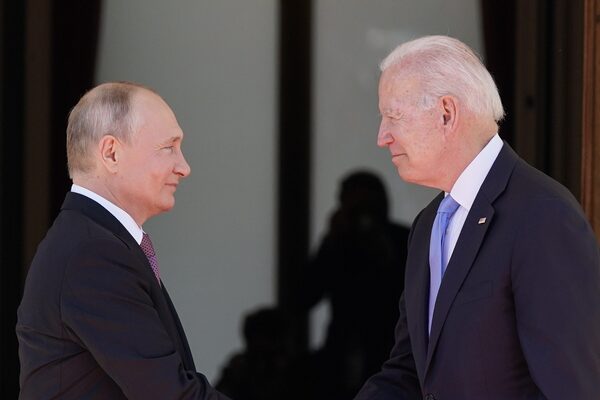
President Joe Biden and Russian President Vladimir Putin, arrive to meet at the 'Villa la Grange', June 16, 2021, in Geneva, Switzerland. Biden and Putin spoke on Dec. 30, as the Russian leader has stepped up his demands for security guarantees in Eastern Europe.Patrick Semansky/The Associated Press
As is the wont of autocrats and demagogues, Russian President Vladimir Putin has a knack for turning the tables on his adversaries by making them look like the invaders.
This talent, for lack of a better word, was on full display during Mr. Putin’s marathon year-end press conference on Dec. 23, when he cast Russia’s build-up of an estimated 100,000 troops near the Ukraine border as a normal and rational response in the face of NATO provocation.
“Are we placing missiles near the border of the United States? No, it is the United States with its missiles that came to our doorstep,” Mr. Putin said, in reference to North Atlantic Treaty Organization defence-missile systems in Poland and Romania. “Is it an excessive demand – no more attack weapons systems near our home? Is there something unusual about this?”
The narrative according to which Western leaders have pushed Mr. Putin to the brink by welcoming a succession of former Soviet bloc countries into NATO – and holding out the possibility of Ukraine’s future membership – is one that has gained increasing currency among foreign policy analysts critical of U.S. and European efforts to isolate Russia. Whether it is an accurate description of the situation is a matter of considerable debate. But it has become clear that what started out as a Western strategy of deterrence is being spun as a provocation by Mr. Putin, and one that he is using to justify his threat to invade Ukraine.
Mr. Putin’s latest demands were contained in “draft agreements,” submitted this month to Washington and Brussels, that NATO formally undertake to never accept Ukraine as a member and reduce or cease its current activities in Eastern Europe – or else. The ultimatum has left U.S. President Joe Biden in a dangerous predicament. The two leaders spoke by phone on Thursday – Mr. Putin reportedly requested the call – in the latest effort to defuse what U.S. officials described as a “moment of crisis.”
A durable resolution to the crisis, if there is to be one, will hinge on a series of negotiations later this month – first between Russian and American diplomats, followed by talks at the NATO-Russia Council and at the Organization for Security and Co-operation in Europe. But no one really doubts that the fate of NATO and Ukraine are now in the hands of the man in the Oval Office.
After presiding over the U.S. military’s chaotic withdrawal from Afghanistan in August, Mr. Biden does not have a lot of goodwill left among NATO allies. His unilateral decision to pull out of Afghanistan left U.S. allies, including Canada, scrambling to rescue their own citizens and Afghans who faced persecution by the Taliban. There is a concern in Europe that Mr. Biden could rewrite post-Cold War security arrangements to get himself out of a geopolitical pickle that is distracting him from repairing his tattered domestic agenda.
Mr. Putin knows Mr. Biden is unwilling to commit U.S. troops to defend Ukrainian sovereignty. And the U.S. President’s threat to impose tough economic sanctions against Russia if it invades Ukraine are not likely to deter him either. Mr. Putin knows Western Europe, in the throes of a devastating energy crisis, is more desperate than ever for Russian natural gas and will not agree to be cut from it. So, on the face of things, Mr. Putin would appear to have a surprisingly strong negotiating hand, at least for the leader of a waning petrostate.
How much ground is Mr. Biden willing to cede to Mr. Putin to avoid war?
It would be the height of irony if Mr. Biden gave in to any of Mr. Putin’s demands. After all, he was the one who promised to stand up to the Russian President after Donald Trump’s singular passivity in the face of Moscow’s serial intrusions in U.S. domestic affairs.
“I did what I came to do,” Mr. Biden said in Geneva this past June after his first face-to-face meeting with Mr. Putin as U.S. President. “Number one, identify areas of practical work our two countries can do to advance our mutual interests and also benefit the world. Two, communicate directly – directly – that the United States will respond to actions that impair our vital interests or those of our allies. And three, to clearly lay out our country’s priorities and our values so he heard it straight from me.”
Mr. Putin is clearly testing Mr. Biden’s willingness to back up his words with actions. How the U.S. President responds will have lasting consequences for his country and the world.
Keep your Opinions sharp and informed. Get the Opinion newsletter. Sign up today.
 Konrad Yakabuski
Konrad Yakabuski